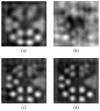A SPECT imager with synthetic collimation
- PMID: 26346410
- PMCID: PMC4558906
- DOI: 10.1117/12.2029745
A SPECT imager with synthetic collimation
Abstract
This work outlines the development of a multi-pinhole SPECT system designed to produce a synthetic-collimator image of a small field of view. The focused multi-pinhole collimator was constructed using rapid-prototyping and casting techniques. The collimator projects the field of view through forty-six pinholes when the detector is adjacent to the collimator. The detector is then moved further from the collimator to increase the magnification of the system. The amount of pinhole-projection overlap increases with the system magnification. There is no rotation in the system; a single tomographic angle is used in each system configuration. The maximum-likelihood expectation-maximization (MLEM) algorithm is implemented on graphics processing units to reconstruct the object in the field of view. Iterative reconstruction algorithms, such as MLEM, require an accurate model of the system response. For each system magnification, a sparsely-sampled system response is measured by translating a point source through a grid encompassing the field of view. The pinhole projections are individually identified and associated with their respective apertures. A 2D elliptical Gaussian model is applied to the pinhole projections on the detector. These coefficients are associated with the object-space location of the point source, and a finely-sampled system matrix is interpolated. Simulations with a hot-rod phantom demonstrate the efficacy of combining low-resolution non-multiplexed data with high-resolution multiplexed data to produce high-resolution reconstructions.
Keywords: BazookaSPECT detectors; GPU; SPECT; Single-photon emission computed tomography; high-performance computing; maximum likelihood; molecular imaging; multi-pinhole imaging.
Figures






References
-
- Barrett HH, Myers KJ. Foundations of image science. John Wiley and Sons; 2004.
-
- Chen YC, Furenlid LR, Wilson DW, Barrett HH. Small-Animal SPECT. Springer; 2005. pp. 195–201. Calibration of Scintillation Cameras and Pinhole SPECT Imaging Systems.
-
- Shepp LA, Vardi Y. Maximum likelihood reconstruction for emission tomography. IEEE Trans Med Imaging. 1982;1(2):113–122. - PubMed
-
- Hudson HM, Larkin RS. Accelerated image reconstruction using ordered subsets of projection data. IEEE Trans Med Imaging. 1994;13(4):601. - PubMed
-
- Branderhorst W, Vastenhouw B, Beekman FJ. Pixel-based subsets for rapid multi-pinhole SPECT reconstruction. Phys Med Biol. 2010;55:2023–2034. - PubMed
Grants and funding
LinkOut - more resources
Full Text Sources
Other Literature Sources
